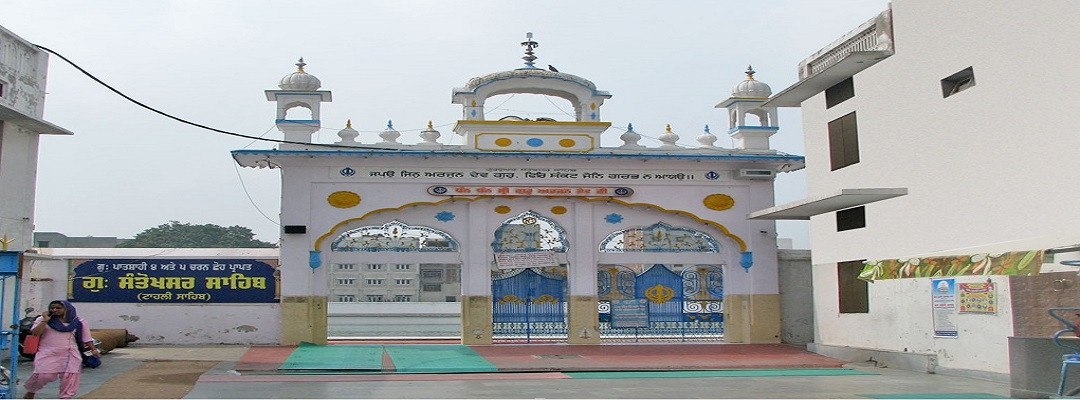Gurdwara Santokhsar Sahib is one of the significant Sikh historical Gurdwaras located in Amritsar, Punjab. The gurudwara features the Santokhsar Sarovar, believed to be the first holy tank excavated in Amritsar.It is one of the five historical sarovars (sacred water tanks) associated with Sikh history and is closely linked to the establishment of Amritsar as the spiritual center of Sikhism. Gurdwara Santokhsar Sahib is one of the significant Sikh historical Gurdwaras located in Amritsar, Punjab.
Historical Significance:
- Creation of the Sarovar:
- Gurdwara Santokhsar Sahib stands by a sacred sarovar (tank) that was started under the guidance of Guru Ram Das Ji, the fourth Sikh Guru.
- The sarovar was later completed by Guru Arjan Dev Ji, the fifth Sikh Guru.
- The name “Santokhsar” is derived from the word ‘Santokh’, meaning contentment, signifying the spiritual tranquility offered by this site.
- According to history, Guru Ram Das Ji came from Goindwal Sahib in samvat:1629 and started digging the Amrit Sarovar. Thus the sarovar has the distinction of being the first sarovar in the history of the Guru. Then in the samvat:1645, Guru Arjan Dev ji started the karsewa and hundreds of Sikhs started contributing into karsewa. The sangats started doing kar seva (carrying earthen baskets in rows and rows) chanting Sat Naam Sri Waheguru.
- Legend of Santokhsar:
- It is believed that while Guru Sikh enthusiastically dug a sarovar and carried soils out and a monastery (a kind of cave) came out from under the excavation of the sarovar. By the Guru’s order, the monastery was opened and a yogi was sitting in meditation. Whose forehead shone like a star. When the Yogi opened his eyes and saw Guru Arjan Dev Ji, the Yogi placed his head at the Guru’s feet and requested that I have been sitting here for a long time by the order of my Guru. Guru Arjan had lent him wisdom and given him contentment.a devotee named Santakha, who had been cursed, achieved liberation here through prayer and devotion. The name of the Gurdwara and the sarovar is said to be inspired by this devotee’s story.
- Connection to Guru Arjan Dev Ji:
- Guru Arjan Dev Ji envisioned creating a spiritual hub in Amritsar, and Santokhsar Sahib was among the first sarovars developed as part of this vision.
- After completing Santokhsar Sahib, the work on the more renowned Amrit Sarovar (Golden Temple complex) began.
- The Guru used to sit under the Tahli. Hence the name of the Gurdwara is popularly known as Gurdwara Tahli Sahib
Architectural Features:
- The Gurdwara is built in the traditional Sikh architectural style, with a serene environment that complements the sacred sarovar.
- The holy tank is an integral part of the site, with devotees often taking a dip as an act of purification.
Significance for Devotees:
- It is considered auspicious to visit Gurdwara Santokhsar Sahib during a pilgrimage to Amritsar.
- Devotees engage in kirtan, ardaas (prayers), and partake in langar (community meals) at the Gurdwara.
- The sarovar is believed to possess spiritual and purifying qualities, bringing peace and contentment to those who visit.
Location:
- Address: Near Golden Temple Complex, Amritsar, Punjab, India.
- It is conveniently located near other major Sikh historical sites, making it a must-visit for pilgrims and tourists alike.
MAJOR ATTRACTIONS
Golden Temple Amritsar
Amritsar is world-famous for the beautiful and highly revered Golden Temple or Sri Harmandir Sahib, which is one of the most prominent spiritual sites in the country.
Ram Tirath
When it involves the Hindu Religion, there are several main important areas that tourists and citizens alike will flock to after their Amritsar flight.
The Akal Takht
Amritsar is world-famous for the beautiful and highly revered Golden Temple or Sri Harmandir Sahib, which is one of the most prominent spiritual sites in the country.



